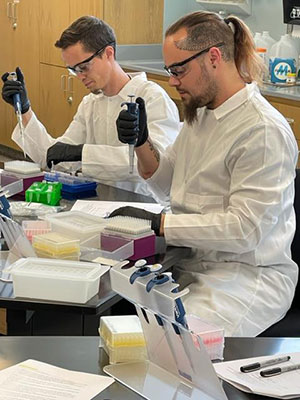AC and City of Amarillo collaborate on mosquito virus-research project
A pair of Amarillo College students learned a great deal more about mosquitoes this summer than they ever thought they might.
They owe it all to the City of Amarillo, AC’s amply equipped STEM Research Center and, yes, a fortuitous reduction in local bus service.
Marcus Baber-Newton and Dustan Francis took part in a special research project in which the College and the City of Amarillo’s Environmental Health Department collaborated to discern if locally captured mosquitoes carried harmful diseases.
The students helped trap a quantity of insects at multiple city locations, learned how to classify and separate out the notorious, virus-transmitting female mosquitoes, processed them, and performed the necessary high-tech analyses.
“It was amazing to learn a whole process that I didn’t even know existed,” Francis said, “and just learning about all the types of mosquitoes was fascinating. It opened a whole new door for me, a whole new world, actually.”
The project, which was funded by a combination of city dollars and AC’s HSI-STEM Grant – for the acquisition of an RNA-extraction kit and a Real-Time PCR molecular testing kit – also gave the students who did the heavy lifting the basis for a research presentation.
Baber-Newton and Francis will publicly present “Presence of Vector-Borne Mosquito Viruses in Amarillo, TX,” at noon on Friday, Sept. 2 in the College Union Building’s Oak Room on the Washington Street Campus.
The study, undertaken during a week in late June, was part of the Environmental Health Department’s Vector Control Program. In addition to practicing mosquito abatement the City also regularly traps specimens to send to the state lab in Austin for thorough analysis – to learn if they carry any dangerous viruses.
At least that was the normal routine before bus delivery services were curtailed.

“We always sent our specimens to Austin by bus, but when our shipper closed everything changed,” Anthony Spanel, Amarillo’s environmental health director, said. “We were looking for a local solution and came to find out that the College not only had the wherewithal to perform the exact same lab tests that they do in Austin, but that they could do it in real time.”
That’s because the College’s STEM Research Center is equipped with a state-of-the-art PCR (polymerase chain reaction) detection system. The intricate device is capable of amplifying small segments of DNA and detecting and quantifying microbial agents, including certain viruses – in short order.
“We didn’t have to wait two weeks for results like we always had before,” Spanel said. “AC gave us the results in days, not weeks. I think this sort of collaboration is fantastic, and we’re definitely interested in expanding the relationship because it both serves our community and puts students on paths to environmental careers.
“We had a need and AC had a solution.”
The good news is that the researchers did not, in this particular study, discover a single mosquito that carried any of the three common viruses for which they tested – West Nile, Eastern Equine Encephalitis or St. Louis Encephalitis.
Of course, there were other gratifying aspects of the study.
“This type of research opportunity is invaluable for our students,” said Teresa Gaus-Bowling, faculty program coordinator at AC. “Learning molecular techniques is the bread and butter of biotechnology, the kind of skills that are transferable to any career pathway in STEM (science, technology, engineering and math).
“And all our controls came up positive, so we know they did it right,” she said.
In addition to Gaus-Bowling, Dr. Jacob Price, assistant professor of biological sciences, and Crystal Moss, coordinator of the STEM Research Center, also helped facilitate the study while mentoring the student volunteers.
“Our students not only used cutting-edge equipment to conduct Tier I-level biotechnology research,” Price said, “but their specimen-collection data helped the Department of Environmental Health in Amarillo to adjust their treatment plans and better pinpoint their abatement strategies around the city.
“These types of real-world collaborations definitely benefit our students and our community, and now our data has become part of the state’s data bank.”
Zac Badrow, environmental health specialist who leads the City’s mosquito abatement efforts, said he and Price have had many discussions over time about ways of getting AC students involved in ongoing environmental projects.
“When this specific need came up regarding our sudden inability to transport specimens to Austin, I mentioned to Dr. Price that we had a need to conduct molecular studies locally, and he said ‘we can do that.’
That opened the door, he said, and the state’s chief entomologist willingly provided the College with the protocols commonly used for testing pathogens.
“AC basically has everything we need right here to get the job done. It’s not only great for their students, but it’s the kind of thing that appeals to employers who are looking for folks with real-world experience,” Badrow said. “I am hopeful that this will lead to even more collaborations between AC and the City.”
AC’s STEM faculty is looking closely at the possibility of entering into future collaborations with the City, including duplications of the study undertaken in June; for the Environmental Health Department would like to resume its traditional biweekly virus-testing protocols.
The availability of funding sources, laboratory time, and interested student volunteers will all be part of that particular equation moving forward.